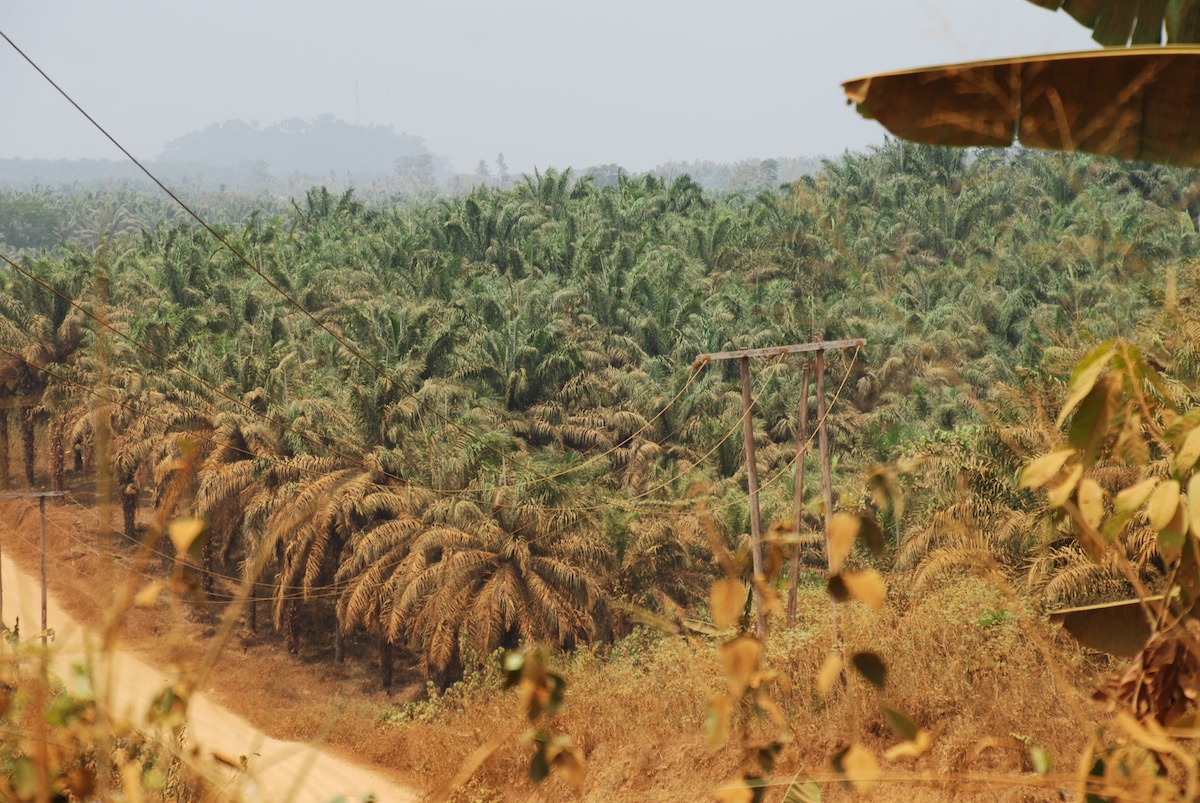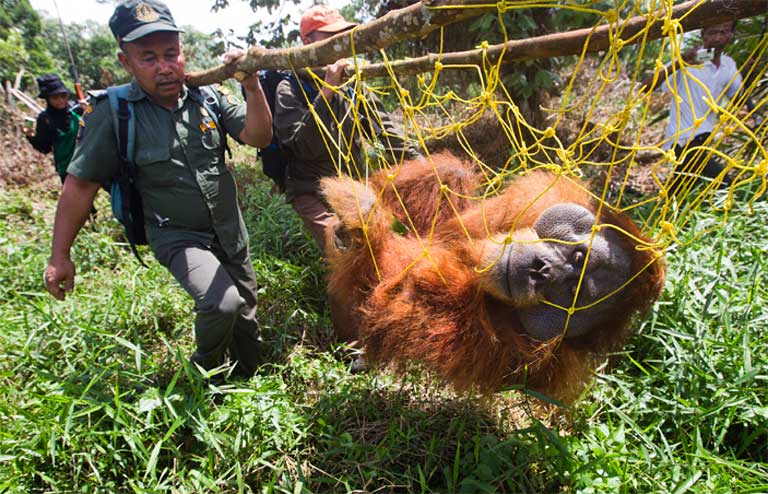- From the Niger Delta in the 1850s to modern-day Indonesia and Honduras, Planet Palm weaves a nuanced and gripping narrative out of the history of palm oil.
- The book meticulously covers the colonial beginnings of the industrial palm oil trade and the fortunes made from its popularity in Europe and later, Asia.
- As battles rage over the ecological and labor rights track record of the palm oil industry, Planet Palm is an excellent and readable overview of one of the biggest issues in environmentalism.
In the pantheon of global commodities that play starring roles in our narratives of history, palm oil tends to occupy a seat far in the back. We know the search for gold in the “New World” led to genocide and colonialism, that Europe’s appetite for confectionery treats produced a global trade in sugar, and understand that the network of plantations built to supply that appetite led to one of the great evils of history: the commodification of human bodies in the form of the trans-Atlantic slave trade. But few know much about the role that palm oil has played in shaping the modern world, let alone how much of it they consume on a daily basis or why it matters.
In Planet Palm, journalist and author Jocelyn Zuckerman aims to change that. Over more than a century, from the precolonial kingdoms of the Niger Delta to modern-day European capitals where debates over biofuels rage, Zuckerman brings the tiny red palm fruits into the spotlight they deserve, revealing their outsized impact on our planet, its politics, and our health.
I first met Zuckerman while working as an investigative researcher with a Liberian community rights organization in 2014. We were raising the alarm over land grabs by Indonesian and Malaysian palm oil companies, and she was reporting on the remote conflicts for Nature magazine. Since then, Zuckerman has traveled across the world, visiting a kaleidoscope of cities, forests, and archives where the palm oil trade stretches back in time to tell its story and reveal its ghosts.
So many years later, absorbing that history as it unravels though the chapters of Planet Palm, I was struck by how much of what I saw in Liberia — the horrendous treatment of workers, deceptive promises made to forest communities, and chilling harassment of activists — is a feature rather than a bug of the global palm oil trade, and has been for more than a century.
Through a mix of on-the-ground reportage and archival research, Planet Palm takes readers on a journey through the story of the thick, aromatic red oil, beginning in its birthplace: West Africa. Here, she traces the life of George Goldie, a directionless aristocrat who found his purpose, along with vast wealth and power, by securing control of the Niger Delta’s palm oil trade routes, shooting and shelling his competition — the once-mighty local traders of the delta — into submission before the British crown.
In one lingering anecdote, Zuckerman describes Jaja, a former slave who became one of the most powerful palm oil traders in the delta, claiming the title of king before the British decided he was too big of a threat to their businesses and orchestrated a kidnapping that ended with his exile and death in the West Indies.

As violent entrepreneurs like Goldie pressured the British government to assert greater control over the rivers from which the prized oil flowed (and which one day would be stricken by another kind of oil), the colony of Nigeria was born — largely, in Zuckerman’s account, to secure British control over the delta’s palm oil trade. Later, we learn of a young grocer from England named William Lever, who supplied Europe’s growing demand for soap products by partnering with King Leopold in the then-Belgian Congo to build vast oil palm plantations and fill them with local labor. The company he built, Unilever, stands today as one of the largest and wealthiest on the planet.
The accounts of Lever’s plantations, rife with forced labor, poor sanitation, and a bizarre cultural paternalism that included the outlawing of palm wine and ritualistic dancing, are a marker both of the sordid history of palm oil and how in some cases very little has changed. To illustrate this, Zuckerman visits temporary workers on a Honduran plantation where electrocutions and other workplace accidents are common, and where those workers are met with violent retribution when they try to organize unions. Linking the current state of palm oil in Central America to the history of the United Fruit Company and its suppression of peasant demands for land redistribution, Zuckerman deftly portrays an industry that is most comfortable and profitable in spaces where repressive politics reign supreme.
Few places illustrate this dynamic more starkly than Indonesia and Malaysia, where palm oil is king. From a cold-numbers economic perspective, the crop has been akin to a miracle for the two Southeast Asian states, driving GDP gains and minting new billionaires as global demand for the oil has skyrocketed. But for forest communities living on Sumatra and Borneo, who say their way of life is vanishing and that they have less to eat as their surroundings are converted to monoculture plantations, the story is not so straightforward. And for Indonesia’s wildlife, there are no shades of gray: the rise of palm oil has been apocalyptic, devastating populations of orangutans and other threatened species as some of the world’s most biodiverse forests vanish under the noses of disinterested local officials.
The Indonesian activists profiled by Zuckerman (local voices feature prominently in her book) say that while it’s true that the industry has created wealth, much of it has been sucked into the cities and bank accounts of prominent politicians, encouraging patronage, corruption and other ills. (I read her book in tandem with Vincent Bevins’s The Jakarta Method, which investigates CIA links to the 1965 mass extermination of land reformers, unionists and communists in Indonesia, and it was impossible not to feel that history casting a sickly shadow over her present-day account.)

Planet Palm also looks at the health impacts of palm oil — namely, growing epidemics of obesity and heart disease in India and other parts of the developing world, where it is increasingly used to produce low-cost snacks. As the costs of palm oil have entered the public consciousness, PR battles are being waged in consumer markets over what ethical production looks like, and who gets to decide. For Indonesia, anti-palm oil campaigning is an existential threat, and Zuckerman describes the pushback from the industry and its lobbing firms, who call the backlash “green neocolonialism,” designed to protect legacy vegetable oil industries in the West from competition.
To cure us of the idea that there is something inherently sinister about palm oil itself, we also meet its traditional custodians and see how differently they relate with it than the global market has. In the Brazilian state of Bahia, for example, Afro-descended practicioners of candomblé use the oil in everything from elaborately cooked dishes to ritualistic offerings to their deities. Known once as “people of the oil,” candomblé devotees reclaim it from before the era when it was painted on their ancestors’ bodies to hide wounds acquired during their passage on slave ships.
In all, Planet Palm portrays the palm oil industry as a stand-in representative for the ills of the capitalist global economy. Forged in colonialism, honed through the industriousness and technological innovation of the previous two centuries, and now expanding in a multitude of hands across the planet as a twin force of wealth generation and stunning ecological devastation, there are no simple answers for the consequences of its rise, yet no possibility of leaving it unchanged either. Arguments over what that change should look like continue to boil, most recently in the wake of the EU’s decision to ban palm oil as a biofuel and the recriminatory threats of trade warfare made by Indonesia and Malaysia in response.
For readers looking for a good primer on palm oil’s field of battle and how it was set, Planet Palm is an illuminating read, as engrossing as it is informative. Those who take some time with it will understand palm oil as a force of modern history and see just how much of the world map has been stained in red oil, as George Goldie once said he wanted Nigeria’s to be.
Banner image: A man stands before a pile of oil palm fresh fruit bunches in the haze of smoke and fire near Indonesia’s Central Kalimantan capital of Palangkaraya. Photo by Bjorn Vaughn.
